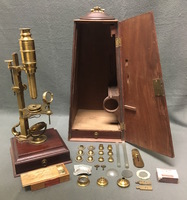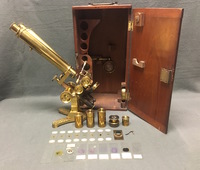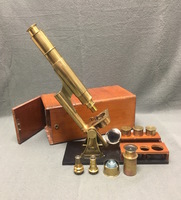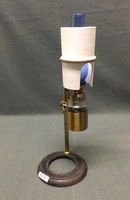Items
Tag
English
-

Dollond Cuff-Type Microscope
The cuff-style compound microscope is made from brass and is secured to a square mahogany base. The single-sided plano-concave mirror is mounted on a gimbal and connected to a brass mounting on the base which can rotate. The Bonnani stage is signed "Dollond London" and has a small removable bullseye condenser attachment. Beneath the stage are two stage clips which hold the specimen in place. The instrument comes with a removable spring-loaded attachment which slots into the circular cut out and acts as a method to hold a specimen in place. The stage is supported by a rectangular pillar, which is parallel to another movable pillar for coarse focusing. The movable pillar slides up and down, adjusting the body tube relative to the stage. The focusing is controlled by a Hevelius screw, with the top mount fixing the body tube in position, and the screw thread adjusts the position of the body tube along the pillar. The pillar has numbered markings which represent the position of the body tube from 1 to 6. The body tube sits in the arm attachment at the top of the pillar. The eye piece has a sliding brass protector. The instrument is housed in a pyramid-shaped mahogany case with an interior draw in the base. The case has a brass carrying handle and is secured by a lock, however, the key is not present with the instrument. -

John Browning Compound Microscope
The binocular microscope is marked "John Browning London. 280" on the stage. The compound microscope is made from brass and stands on a splayed Y-shaped foot with a decorative varnish. The lower limb ends in an inclination joint which allows for angling for observation. The microscope also consists of a sub-stage plano-concave mirror which sits in a gimbal and an arm extension which allows for adjustment. The square stage also has a decorative pattern which matches the foot. The stage has an attachment to hold the slides in place as well as two removable stage clips to hold slides in place. The slide can be adjusted via the X and Y axis by the two thumbscrews on the side of the stage. The instrument also has a sub-stage iris diaphragm with three apertures which can be adjusted by swiveling the disc. Coarse focusing is achieved by a rack and pinion mechanism controlled by a large thumbscrew parallel to the stage. Fine focusing is controlled by the by a smaller thumbscrew at the end of the body-tube. -

Smith & Beck "Milk Box" Educational Microscope
This microscope is a rare example as it has a cast iron base which appears to have been purpose-built rather than retrofitted. The actual instrument has been stripped of its gunmetal and black lacquers. The microscope is signed with a stamped with "Smith & Beck, London" on the side pillar. The cast iron base is attached to the dual side pillars which end in trunnions that allow for inclination. The square stage has a substage iris diaphragm which can be removed and a substage plano-concave mirror set in a gimbal. Coarse focusing is achieved by sliding the body-tube through the cylinder attachment connected to the main pillar. The fine focusing is controlled by knurled knob at the base of the pillar and the cast iron base is attached to a mahogany accessories tray that holds the objective and objective lens. The mahogany case is secured by a lock and key, which is broken. The base slides into the case horizontally. The microscope design was low end and became eclipsed by the binocular version — "Popular Microscope" — by 1865. The instrument was described by Richard Beck in his book, A Treatise, in 1865 and reviewed by Gerald Turner in his book, The Great Age of the Microscope (1989). -

Microscope Lamp
The lamp is made from brass and cast iron. The instrument stands on a cast iron circular stand which is painted black. The circular column is connected to the base and holds the lamp via an arm. The lamps height can be adjusted by loosening the thumbscrew and adjusting the height along the column. The glass and brass reservoir is connected to the burner and has a blue glass chimney with a white porcelain shade which is removable. The shade is held by a circular attachment which stands adjacent to the column and can be adjusted vertically by a thumbscrew located at the bottom of the arm.